Q&A – Ask Neil: July 18, 2024
(Please read these instructions carefully.)
Before you post your question, please look at recent issues to see if someone else has already asked it. You might find your answer there.
How to submit your question…
(Note: You may need to allow a pop-up window to come up in order to get the link for sending your photo(s). If you have already submitted your question and didn’t see the pop-up window, please click here.)
• Click the link provided below to post your question. After you submit your question, a new window will pop up giving you the address to which you can e-mail a SHARP, HIGH-RESOLUTION PHOTO to accompany your question. Please DO NOT SEND THUMBNAIL PHOTOS in case I need to zoom in to see things.
• Click here to post your question.
• Please ONLY POST YOUR QUESTION ONE TIME. We can only accept a set number of questions each week, and when we get duplicates it costs other people their chances.
• One question per reader, please.
• Please use this only for posting questions – not for standard emails.
• Watch for your answer in the following week’s e-gardens.
• I choose those of greatest general interest. For example, plant IDs seldom make the cut.
• I must have your first name or initials.
• I must have your city or county. (Texas is a very large state.)
QUESTION 1
WILL PINE BARK MULCH ATTRACT ROACHES?
Question: You recently recommended using pine bark mulch. My wife is worried that it will attract roaches. Should I be concerned? If so, is there another good mulch that won’t attract these pests? David Y., Rowlett.
Answer: I figured the other day that I have taken 450,000 questions on the radio and through my Q&A columns. I’ve never had this one before, so I went to the Internet. Yes, there is discussion about roaches favoring places where we have used mulches because those spots are cool and moist.
But, whoa! Wait a moment! That’s exactly why we use mulches. Because they conserve water in our soils and because they moderate the soil temperatures in summer (and winter). It doesn’t matter whether it’s an organic or inorganic mulch. Mulches benefit our plants.
I noticed that most of the matches I got were from pest control companies or companies wanting to sell us products to get rid of roaches. No university entomology or horticulture specialist ventured forth to suggest that we shouldn’t use mulches on the grounds that they attract roaches. I use 50 or so bags of finely ground pine bark mulch in our landscape each year and I don’t recall ever seeing roaches fleeing out of it when I have worked in my yard and gardens. Sure, we see insects in our yard, in our landscape, and occasionally in our house, but we deal with the harmful ones with perimeter foundation control around the outside and baseboards of our house. We are sure to keep weatherstripping in good working order as well.
Everything I read said that roaches and other insects have no preferences between the different types of mulches. Keep in mind that fallen leaves that accumulate at certain times of the year, stacks of firewood we store near the back door, and even grass clippings that build up over time give the same accumulations of organic matter that could attract the pests. I’m going to have to leave that decision up to you and your wife. It’s a personal decision. For me, I’ll keep using the mulches.
QUESTION 2
HOW CAN I ELIMINATE GROUND CHERRY FROM MY BERMUDA LAWN?
Question: How can I eliminate ground cherry from my hybrid bermuda lawn? Weldon G., Childress.

Answer: For what it’s worth, this doesn’t look like the plant I know as ground cherry. Nonetheless, it’s definitely not a grass, so a broadleafed weedkiller spray (containing 2,4-D) will control it. Use a pump sprayer or trigger squeeze bottle for small jobs. Droplets should be fine. If the herbicide beads up and rolls off the leaves, include one drop of liquid dishwashing detergent per gallon of spray to reduce the surface tension on the leaves. Do not mow for several days before or after you spray. You may have to repeat the treatment 3 or 4 weeks later since the weeds are almost dormant at this hot, dry time.
QUESTION 3
IS OUR NEW REDBUD NOT RECEIVING ENOUGH WATER?
Question: This redbud was purchased through the mail 5 or 6 weeks ago. I’m concerned about the browning leaves. I find no insects. Is it not receiving enough water? It is in the sun most of the day. Do you have any suggestions? Carol B., Waxahachie.
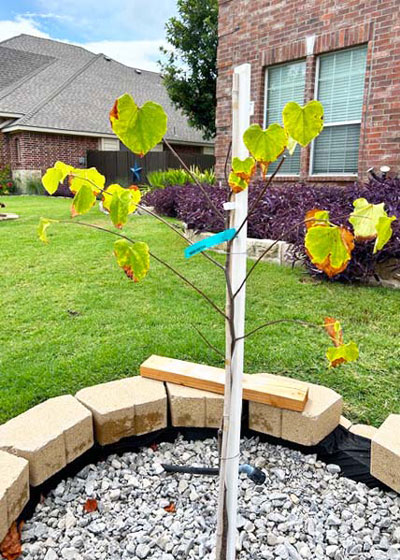
Answer: That’s a really rough time of year to be setting out a young redbud, especially one that was purchased through the mail. Hopefully it had been grown in a container so that you have all of its original roots. It may have become acclimated to less than full sunlight while it was being shipped. Setting it out into the blazing Texas summer sun right after the end of the rainy spell was a shock to it. It is struggling with moisture stress, as evidenced by the tip and edge burn to the leaves. Keep the tree watered regularly with a garden hose (as opposed to your lawn sprinkler) the balance of the summer and fall.
QUESTION 4
HOW SHOULD WE TRANSPLANT IRIS AS WE MOVE SOON?
Question: We will soon be moving to another house nearby. Would transplanting my irises into large pots and keeping them watered and out of afternoon sun be a good plan until I can plant them into the ground in the fall? Pamela B., Waco.
Answer: Yes. It’s as if you’ve read the instructions directly from the iris growers themselves. Their societies often have plant sales in late summer and that’s exactly how they recommend handling the plants. However, they usually have broken their large clumps into individual fans or smaller clumps. It sounds like you’re trying to disturb them as little as possible. Good plan.
QUESTION 5
HOW CAN I ELIMINATE VOLUNTEER CRAPE MYRTLES?
Question: Is there any way to get rid of volunteer crape myrtle plants that spring up in the same flowerbed where the original crape myrtle was? They keep coming up and it’s very difficult to pull them up. Linda L., Mansfield.
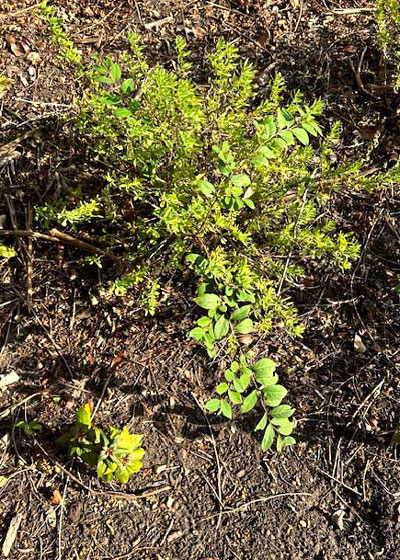
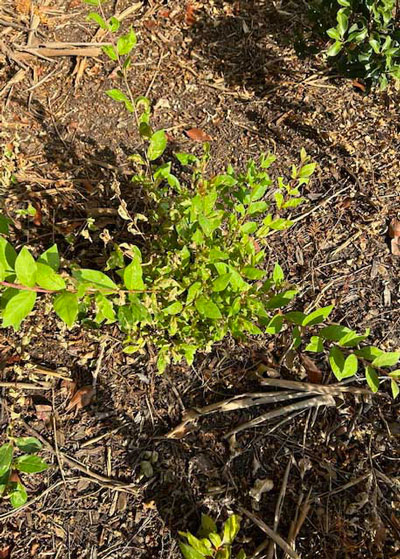
Answer: Those are root sprouts that are originating from the lateral roots of the mother plant. That’s why they’re difficult to pull. You’d be better off soaking the area, then later that day, using a sharpshooter spade to angle down through the main root. It will be very boring work the first time you do it, but each time that you remove one of them you will be making serious inroads into reducing the population. I had the same issue when I transplanted a large Catawba crape myrtle. Within 2-3 years I was rid of them.
QUESTION 6
WHAT HAPPENED TO MY ROSE-OF-SHARON?
Question: My rose-of-Sharon bush has flowered beautifully for 10 years. This year, however, it bloomed, struggled, and died. I found spider mites on it and sprayed, but to no avail. This area gets water regularly. Is there any hope it will come back? What can I do? Rachel H., Allen.
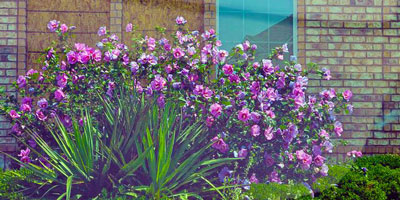
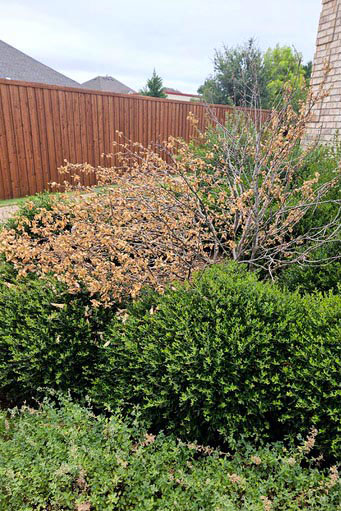
Answer: This is cotton root rot, a soil-borne fungus that kills even mature trees and shrubs within just 1-2 weeks after lying dormant in the soil for 10 or 15 years. The scientific name of the fungus gives a quick idea of the magnitude of its impact: Phymatotrichum omnivorum. It’s that species name “onmivorum” that tells you that it impacts a huge portion of our plant population – it is “omnivorous.” Members of the Cotton Family such as roses-of-Sharon are especially vulnerable. Sadly, your plant is dead and cannot be brought back to life. I’ve lost a couple of nice althaeas just as you have. Replant with a resistant species such as a large type of holly or crape myrtle. They are highly resistant if not immune.
QUESTION 7
WHAT IS THIS GRASS AND HOW CAN I CONTROL IT?
Question: Most of my 15,000 sq. ft. lawn is bermudagrass. I cut it at 3/4-inch. Now I have this other grass coming in. What is it, and how can I stop it? Robert J., Williams (Van Zandt County).
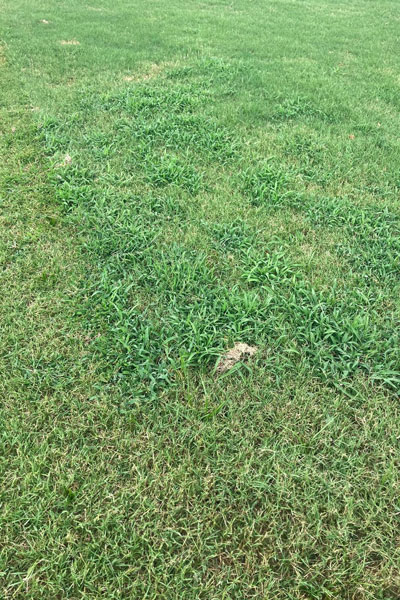
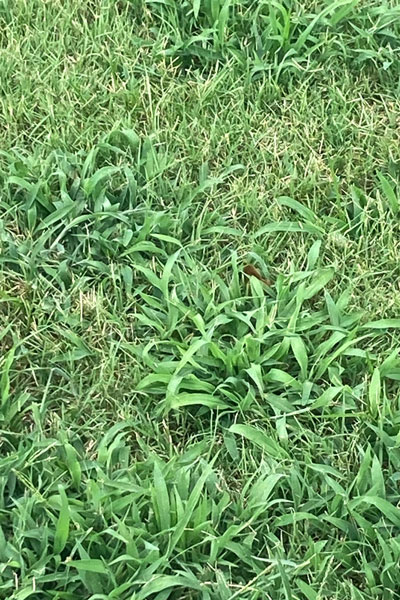
Answer: It looks like crabgrass, but I’d have to see a seedhead to be sure. In the absence of that I’ll include my own photo of crabgrass in seed so you can compare for yourself when yours starts flowering and seeding.
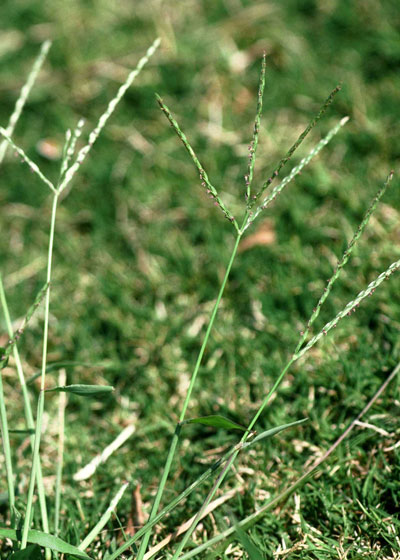
Grasses are challenging to control within other grasses. For most of my career I was able to recommend MSMA for that job when the grassy weeds (even St. Augustine) were invading bermuda turf. However, 12 or 14 years ago, MSMA was taken off the consumer market. Golf course managers and highway departments can still buy and use it. I see it sold online in commercial quantities, and I don’t see where a license is required for such purchase. But, I can’t recommend that you buy and use it. If you do have crabgrass, you can prevent its germination by applying pre-emergent granules Dimension, Halts, or Balan two weeks prior to the average date of your last killing freeze and then again 90 days later in the spring. Where you are that would mean March 5-15 and again June 5-15.
QUESTION 8
WHAT IS WRONG WITH MY AUTUMN BLAZE MAPLE?
Question: Why is my Autumn Blaze maple losing big pieces of bark? I’ve had the tree 20 years. This loss of bark is happening on the northeast side of the trunk. Will it kill the tree? What should I do to stop it? Joe S., Bowie.
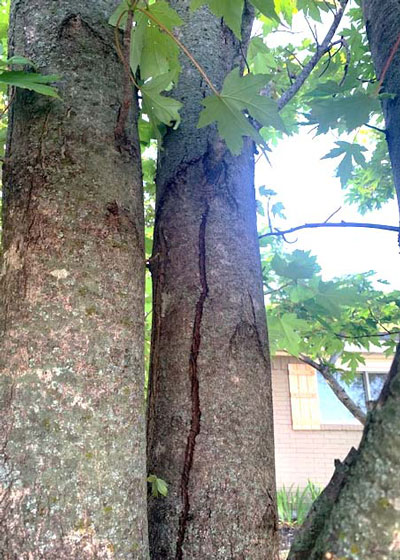
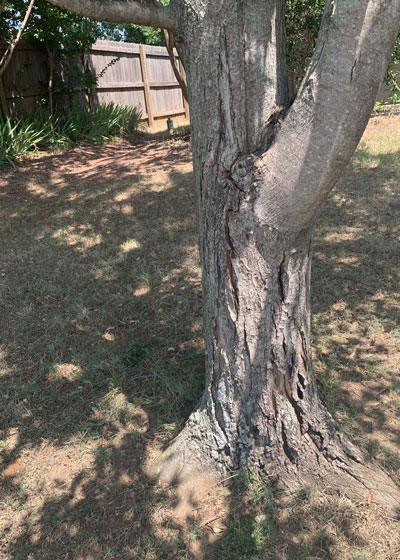
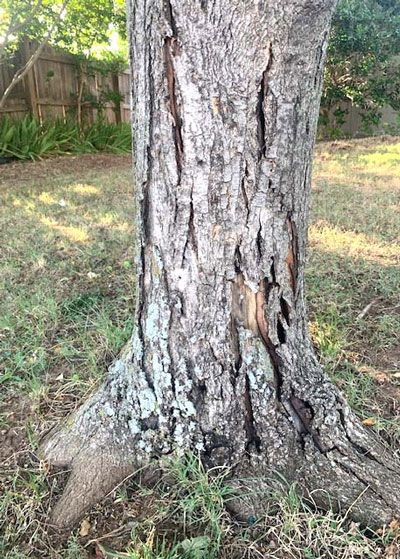
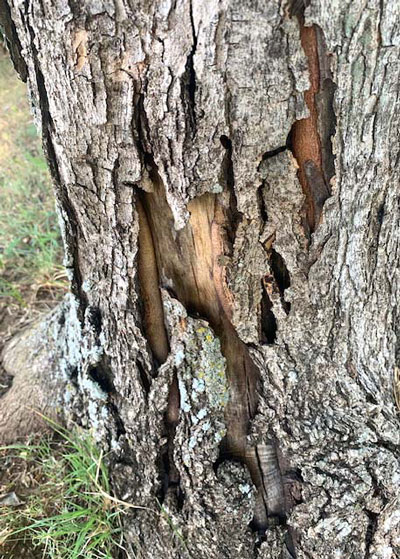
Answer: Joe called my statewide radio program last Saturday morning. The more we spoke about his tree the more I realized I needed to see photos of the tree to be able to help him accurately. He sent me several outstanding photos through a special contact box I save for radio callers in this sort of a dilemma. Thanks, Joe.
Let me address things many of you have heard me talk and write about before here and on the air. This is not damage done by sun scald. The sun would never hit the northeast side of a tree’s trunk. Second, that damage would show up after 3-5 years and certainly not after 15-20.
When I look at the closest-in photo I can see dead, dry wood within the tree’s trunk. It has taken on the weathered, gray appearance. That is not a good sign. I also see evidence of decay. But I can’t see a point source of where that decay might have originated. Perhaps there was a small twig that died and wasn’t removed flush with the trunk. That’s how decay can get started and then it can move up and down within the trunk.
Bark splitting and sloughing off is a normal thing with red maples and many other species of shade trees. Their trunks expand as the trees prosper and grow, but the dead bark cannot expand. But when it sloughs off and new bark doesn’t form beneath it, that’s when you know you have a problem.
Since I can’t see where this problem might have gotten its start I am going to suggest that you hire a certified arborist to inspect your tree carefully. Do not do a lot of probing yourself. Hopefully the tree will be able to heal across the wound and keep on growing vigorously. Good luck!
